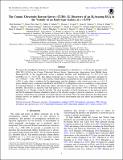| dc.contributor.author | Boettcher, Erin | |
| dc.contributor.author | Chen, Hsiao-Wen | |
| dc.contributor.author | Zahedy, Fakhri S | |
| dc.contributor.author | Cooper, Thomas J | |
| dc.contributor.author | Johnson, Sean D | |
| dc.contributor.author | Rudie, Gwen C | |
| dc.contributor.author | Chen, Mandy C | |
| dc.contributor.author | Petitjean, Patrick | |
| dc.contributor.author | Cantalupo, Sebastiano | |
| dc.contributor.author | Cooksey, Kathy L | |
| dc.contributor.author | Faucher-Giguère, Claude-André | |
| dc.contributor.author | Greene, Jenny E | |
| dc.contributor.author | Lopez, Sebastian | |
| dc.contributor.author | Mulchaey, John S | |
| dc.contributor.author | Penton, Steven V | |
| dc.contributor.author | Putman, Mary E | |
| dc.contributor.author | Rafelski, Marc | |
| dc.contributor.author | Rauch, Michael | |
| dc.contributor.author | Schaye, Joop | |
| dc.contributor.author | Simcoe, Robert A | |
| dc.contributor.author | Walth, Gregory L | |
| dc.date.accessioned | 2022-04-29T16:38:41Z | |
| dc.date.available | 2022-04-29T16:38:41Z | |
| dc.date.issued | 2021 | |
| dc.identifier.uri | https://hdl.handle.net/1721.1/142207 | |
| dc.description.abstract | We report the serendipitous detection of an H2-bearing damped Lyα absorber at z = 0.576 in the spectrum of the QSO J0111–0316 in the Cosmic Ultraviolet Baryon Survey. Spectroscopic observations from Hubble Space Telescope-COS in the far-ultraviolet reveal a damped absorber with log[N(H i)/cm−2] = 20.1 ± 0.2 and log[N(H2)/cm−2] $={18.97}_{-0.06}^{+0.05}$. The diffuse molecular gas is found in two velocity components separated by Δ ν ≈ 60 km s−1, with >99.9% of the total H2 column density concentrated in one component. At a metallicity of ≈50% of solar, there is evidence for Fe enhancement and dust depletion, with a dust-to-gas ratio κO ≈ 0.4. A galaxy redshift survey conducted with IMACS and LDSS-3C on Magellan reveals an overdensity of nine galaxies at projected distance d ≤ 600 proper kpc (pkpc) and line-of-sight velocity offset Δ νg ≤ 300 km s−1 from the absorber. The closest is a massive, early-type galaxy at d = 41 pkpc that contains ≈70% of the total stellar mass identified at d ≤ 310 pkpc of the H2 absorber. The close proximity of the H2-bearing gas to the quiescent galaxy and the Fe-enhanced chemical abundance pattern of the absorber suggest a physical connection, in contrast to a picture in which DLAs are primarily associated with gas-rich dwarfs. This case study illustrates that deep galaxy redshift surveys are needed to gain insight into the diverse environments that host dense and potentially star-forming gas. | en_US |
| dc.language.iso | en | |
| dc.publisher | American Astronomical Society | en_US |
| dc.relation.isversionof | 10.3847/1538-4357/ABF0A0 | en_US |
| dc.rights | Article is made available in accordance with the publisher's policy and may be subject to US copyright law. Please refer to the publisher's site for terms of use. | en_US |
| dc.source | American Astronomical Society | en_US |
| dc.title | The Cosmic Ultraviolet Baryon Survey (CUBS). II. Discovery of an H 2 -bearing DLA in the Vicinity of an Early-type Galaxy at z = 0.576* | en_US |
| dc.type | Article | en_US |
| dc.identifier.citation | Boettcher, Erin, Chen, Hsiao-Wen, Zahedy, Fakhri S, Cooper, Thomas J, Johnson, Sean D et al. 2021. "The Cosmic Ultraviolet Baryon Survey (CUBS). II. Discovery of an H 2 -bearing DLA in the Vicinity of an Early-type Galaxy at z = 0.576*." Astrophysical Journal, 913 (1). | |
| dc.contributor.department | MIT Kavli Institute for Astrophysics and Space Research | |
| dc.relation.journal | Astrophysical Journal | en_US |
| dc.eprint.version | Final published version | en_US |
| dc.type.uri | http://purl.org/eprint/type/JournalArticle | en_US |
| eprint.status | http://purl.org/eprint/status/PeerReviewed | en_US |
| dc.date.updated | 2022-04-29T16:33:58Z | |
| dspace.orderedauthors | Boettcher, E; Chen, H-W; Zahedy, FS; Cooper, TJ; Johnson, SD; Rudie, GC; Chen, MC; Petitjean, P; Cantalupo, S; Cooksey, KL; Faucher-Giguère, C-A; Greene, JE; Lopez, S; Mulchaey, JS; Penton, SV; Putman, ME; Rafelski, M; Rauch, M; Schaye, J; Simcoe, RA; Walth, GL | en_US |
| dspace.date.submission | 2022-04-29T16:34:03Z | |
| mit.journal.volume | 913 | en_US |
| mit.journal.issue | 1 | en_US |
| mit.license | PUBLISHER_POLICY | |
| mit.metadata.status | Authority Work and Publication Information Needed | en_US |
